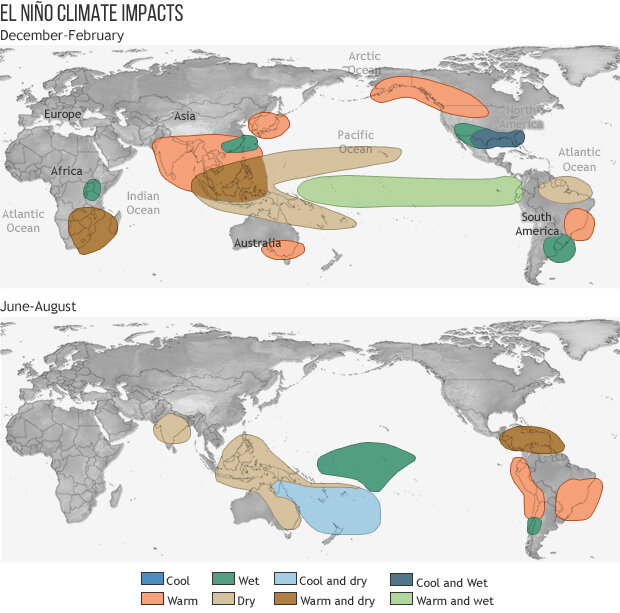JACKSONVILLE, Fla. — The peak of the late winter & spring allergies has come & gone for Jacksonville/NE Fl./SE Ga. But the pollen is at its peak for many northern latitudes & grass allergies in particular will persist through the summer with a shorter but furious grass growing season across the Northern U.S.. From “Lawn Love”:
We compared 131 metro areas based on allergy risk, exacerbators, and access to detection and treatment resources. More specifically, we looked at grass pollen forecasts, allergen intensity, and lawn mowing frequency, among nine total metrics.
Lots of chatter about the potential for an El Nino (warming sea surface temps. near the Pacific equator) & the upcoming hurricane season. In general, El Nino hurricane seasons are characterized by a lower number of Atlantic named storms vs. higher numbers in the E. Pacific Basin. But a couple of potential caveats:
(1) the ENSO cycles (El Nino or La Nina) & the resulting “typical” weather - in my opinion - are less predictable, less reliable now that our world’s oceans are - overall - so warm.
(2) The Atlantic Basin - as a whole - already has above avg. water temps. Now these temps. could “flip” during the hurricane season but the big question - at this point - is will the ocean temps. continue to be above avg. through the hurricane season & - if so - how much (if at all) will these warm water temps. potentially offset the effects of an El Nino.
Check out sea surface temps. anomalies below as of May 9th. The developing El Nino seems to be well underway (look near & off the coast of S. America along/near the equator)... & much of the Atlantic, Caribbean & Gulf of Mexico are above avg. south of 30 degrees N including the Main Development Region (MDR). There is some chilly water over the N. Atlantic.


The National Hurricane Center has issued its verification report for the 2022 season. Some take-aways:
* As one would expect, track verification is much better at 24 hours vs. 96 & 120 hours.
* There continues to be year to year improvement though is beginning to flatline some, especially in the shorter range as technology & skill has leveled off & possibly is reaching near its max accuracy as has been reported by forecasters at NHC.
* Intensity forecasts, on the other hand, remain the biggest bug-a-boo. Even when the general intensity forecast - such as rapid intensification - is on point, the details (exact amount of intensification) remain very difficult to pinpoint in advance.
Get the full NHC report * here *.
Night skies through May into early June from Sky & Telescope:
May 9 (evening): Mars is 5° lower left of Pollux in Gemini. Venus blazes to the pair’s lower right.
May 15 (dusk): Look toward the west to see Mars, Castor, Pollux arranged in a line about 10° long.
May 17 (dawn): The waning crescent Moon and Jupiter rise with less than 1° between them. An occultation will be visible in the Far West.
May 21 (dusk): Look toward the west to see Venus, Castor, Pollux arranged in a triangle. The Moon is at lower right.
May 22 (evening): The waxing crescent Moon and Venus are some 5° apart in Gemini, low in the west-northwest.
May 24 (dusk): The crescent Moon is equidistant (around 4°) from both Mars and the Beehive star cluster.
May 26 (evening): The Moon, one day shy of first quarter, is less than 3½° from Regulus, in Leo.
May 28, 29 (dusk): Venus and Pollux are 4° apart above the west-northwestern horizon.
May 31 (evening): Mars hovers on the outskirts of the Beehive Cluster low in the west after sunset.
June 1 (dusk): Venus forms a tidy line with Castor and Pollux in Gemini.
June 2 (evening): Mars is upper left of the Beehive Cluster in Cancer in the west. Use binoculars to see the cluster stars.
June 3 (dusk): The full Moon trails Antares by about 3° above the southeastern horizon.
June 10 (morning): The last-quarter Moon follows Saturn as they rise in tandem above the southeastern horizon.
Moon Phases:
Last Quarter May 12 10:28 a.m. EDT
New Moon May 19 11:53 a.m. EDT
First Quarter May 27 11:22 a.m. EDT
Full June 3 11:42pm EDT

The week of May 8-12th is “Teacher Appreciation Week”. From Becky Pringle, President of the National Education Association:
It’s a time that lets us reflect on the hard work and dedication of our public school teachers, who today are often more than teachers to our students. Teachers work with parents and caregivers without enough resources. Teachers too often must reach into their own pockets to transform their classrooms into learning environments and must step up to fill in as counselors and nurses for their students. Teacher Appreciation Week comes as the media reports teacher turnover hitting new highs across the United States. To combat teacher shortages, teachers need dignity, respect, and competitive, professional pay to encourage more talented individuals to join the profession.
Upon graduation from college, I was a High School science teacher for 1 1/2 years in Des Moines, Iowa. Just this week, I received this heart warming message from a former student: “Mr. Buresh - I’m so happy to see you’re doing so well!! But in that classroom, You really moved us to be better, and it still lives in my mind!!”
Sometimes one wonders if you have ever really impacted anyone’s lives. Teachers should know they can - & do - make a tremendous difference in the lives of so many young people. It’s a very tough & demanding career. But teachers are critical to the success of the younger generation helping to shape society’s future.











